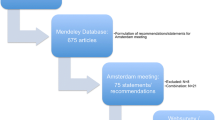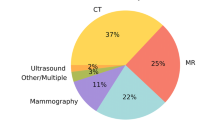Abstract
In 2017, our tertiary hospital-based imaging practice transitioned from score-based peer review to the peer learning methodology for learning and improvement. In our subspecialized practice, peer learning submissions are reviewed by domain experts, who then provide feedback to individual radiologists, curate cases for group learning sessions, and develop associated improvement initiatives. In this paper, we share lessons learned from our abdominal imaging peer learning submissions with the assumption that trends in our practice likely mimic others’, and hope that other practices can avoid future errors and elevate the level of the quality of their own performance. Adoption of a nonjudgmental and efficient method to share peer “learning opportunities” and “great calls” has increased participation in this activity and increased transparency into our practice, thus allowing for visualization of trends in performance. Peer learning allows us to bring our own individual knowledge and practices together for group review in a collegial and safe environment. We learn from each other and decide how to improve together.
Graphical Abstract









Similar content being viewed by others
References
Larson DB, Broder JC, Bhargavan-Chatfield M, Donnelly LF, Kadom N, Khorasani R, et al. Transitioning From Peer Review to Peer Learning: Report of the 2020 Peer Learning Summit. Journal of the American College of Radiology 2020;17:1499–508. https://doi.org/https://doi.org/10.1016/j.jacr.2020.07.016.
Donnelly LF, Larson DB, Iii REH, Kruskal JB. Practical Suggestions on How to Move From Peer Review to Peer Learning. American Journal of Roentgenology 2018;210:578–82. https://doi.org/https://doi.org/10.2214/AJR.17.18660.
Sharpe RE, Huffman RI, Congdon RG, Plunkett LA, Tschumper BA, Stewart DT, et al. Implementation of a Peer Learning Program Replacing Score-Based Peer Review in a Multispecialty Integrated Practice. American Journal of Roentgenology 2018;211:949–56. https://doi.org/https://doi.org/10.2214/AJR.18.19891.
Broder JC, Scheirey CD, Wald C. Step by Step: A Structured Approach for Proposing, Developing and Implementing a Radiology Peer Learning Program. Current Problems in Diagnostic Radiology 2021;50:457–60. https://doi.org/https://doi.org/10.1067/j.cpradiol.2021.02.007.
Kunst MM, Elentuck D, Wald C, Broder JC. Leveraging the Peer Learning Conference to Establish and Maintain a Peer Learning Program. Current Problems in Diagnostic Radiology 2022;51:686–90. https://doi.org/https://doi.org/10.1067/j.cpradiol.2022.04.010.
Bruno M, Walker E, Abujudeh H. Understanding and Confronting Our Mistakes: The Epidemiology of Error in Radiology and Strategies for Error Reduction. RadioGraphics 2015;35:1668–76. https://doi.org/https://doi.org/10.1148/rg.2015150023.
Kruskal JB, Eisenberg RL, Brook O, Siewert B. Transitioning from peer review to peer learning for abdominal radiologists. Abdom Radiol 2016;41:416–28. https://doi.org/https://doi.org/10.1007/s00261-016-0675-1.
Egri C, Darras KE, Scali EP, Harris AC. Classification of Error in Abdominal Imaging: Pearls and Pitfalls for Radiologists. Can Assoc Radiol J 2018;69:409–16. https://doi.org/https://doi.org/10.1016/j.carj.2018.06.006.
Oppenheimer J, Bressem KK, Elsholtz FHJ, Hamm B, Niehues SM. Can optimized model-based iterative reconstruction improve the contrast of liver lesions in CT? Acta Radiol 2023;64:42–50. https://doi.org/https://doi.org/10.1177/02841851211070119.
Solomon J, Marin D, Choudhury KR, Patel B, Samei E. Effect of Radiation Dose Reduction and Reconstruction Algorithm on Image Noise, Contrast, Resolution, and Detectability of Subtle Hypoattenuating Liver Lesions at Multidetector CT. Radiology 2017;284:777–87. https://doi.org/https://doi.org/10.1148/radiol.2017161736.
Caruso D, De Cecco CN, Schoepf UJ, Schaefer AR, Leland PW, Johnson D, et al. Can dual-energy computed tomography improve visualization of hypoenhancing liver lesions in portal venous phase? Assessment of advanced image-based virtual monoenergetic images. Clin Imaging 2017;41:118–24. https://doi.org/https://doi.org/10.1016/j.clinimag.2016.10.015.
De Cecco CN, Caruso D, Schoepf UJ, De Santis D, Muscogiuri G, Albrecht MH, et al. A noise-optimized virtual monoenergetic reconstruction algorithm improves the diagnostic accuracy of late hepatic arterial phase dual-energy CT for the detection of hypervascular liver lesions. Eur Radiol 2018;28:3393–404. https://doi.org/https://doi.org/10.1007/s00330-018-5313-6.
Mayo-Smith WW, Song JH, Boland GL, Francis IR, Israel GM, Mazzaglia PJ, et al. Management of Incidental Adrenal Masses: A White Paper of the ACR Incidental Findings Committee. Journal of the American College of Radiology 2017;14:1038–44. https://doi.org/https://doi.org/10.1016/j.jacr.2017.05.001.
Md P, Sm A, Mm H, Pj P, L P, M G, et al. Management of Incidental Adnexal Findings on CT and MRI: A White Paper of the ACR Incidental Findings Committee. Journal of the American College of Radiology : JACR 2020;17. https://doi.org/10.1016/j.jacr.2019.10.008.
Author information
Authors and Affiliations
Corresponding author
Ethics declarations
Conflict of interest
There are no financial disclosures or competing interests amongst authors.
Additional information
Publisher's Note
Springer Nature remains neutral with regard to jurisdictional claims in published maps and institutional affiliations.
Rights and permissions
Springer Nature or its licensor (e.g. a society or other partner) holds exclusive rights to this article under a publishing agreement with the author(s) or other rightsholder(s); author self-archiving of the accepted manuscript version of this article is solely governed by the terms of such publishing agreement and applicable law.
About this article
Cite this article
Khader, A., Ali, S., Wald, C. et al. Abdominal peer learning: advantages and lessons learned. Abdom Radiol 48, 1526–1535 (2023). https://doi.org/10.1007/s00261-023-03846-9
Received:
Revised:
Accepted:
Published:
Issue Date:
DOI: https://doi.org/10.1007/s00261-023-03846-9




